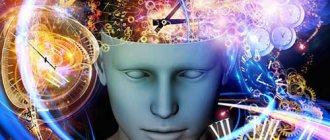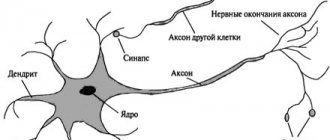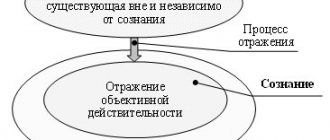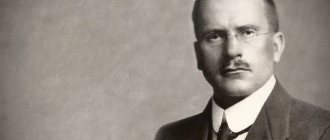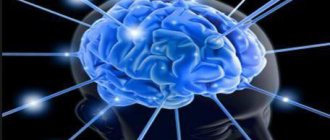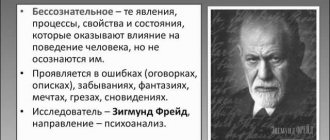Consciousness as the highest form of psyche
The main feature of the human psyche is that, in addition to hereditary and personally acquired forms of behavior, a person possesses a fundamentally new, most important means of orientation in the surrounding reality - knowledge, which represents the concentrated experience of humanity, transmitted through speech. “Consciousness” literally means “the body of knowledge.” The human psyche is formed and constantly enriched in the conditions of the social environment, in the process of assimilating social and public experience. If an animal raised in artificial, isolated conditions retains all its species qualities, then a person without a social environment does not acquire any human qualities.
Theoretical foundations of consciousness
Modern psychologist I. Tulving studied and presented the theoretical foundations of consciousness:
- Anoetic consciousness
(procedural memory) is a state where we are not conscious of anything, but we register environmental cues and respond to them.
- Noetic consciousness
(semantic memory) is a state when we are aware of something that is not part of the existing environment, like symbolic consciousness.
- Autonoetic consciousness
(episodic memory) is what we know about ourselves, the memory of events in our personal life.
Previously, philosophers and psychoanalysts studied consciousness, but Tulving scientifically substantiated his classification and experimentally confirmed it.
The origin of consciousness in evolution
In the history of science, about 40 cases have been described in which children were fed animals from an early age. They did not show not only signs of consciousness (they completely lacked speech and thinking), but even such a physical property of a person as the vertical position of the body when walking. With the transition from animal existence to human society, two new factors in the formation of the human psyche arose: social labor, the use of tools and communication through words. With the advent of upright walking, a person’s hand was freed, his horizons expanded, and conditions arose for the intensive development of his orienting activity. This led to the emergence of tools and the labor process. A person begins to live in a world of permanent tools of labor, through which labor operations are transmitted from generation to generation. Making the simplest tool inevitably requires such conscious actions as a preliminary idea of its functions, shape, and material properties. Actions to manufacture a weapon must be planned in a certain order. They must be realized and remembered for its re-production. The production of tools is associated with the mental division of the whole into parts (analysis), with the isolation (abstraction) of individual properties of an object, as well as with the mental unification (synthesis) of isolated properties into imaginable integral tools. The improvement of labor processes and the production of more and more complex tools was associated with the improvement of the analytical and synthetic activity of the human cerebral cortex; The instrument of this activity—speech—was also improved. The social organization of work activity has led to the identification of individual actions that acquire meaning only through the work of other people. Thus, in work, conscious actions arise, divorced from the immediate biological goal, and a person’s abstract thinking and will are formed.
Brain research, functional asymmetry
The next stage in the study of consciousness is brain research. Let us consider, for example, what contribution the functional asymmetry of the brain makes to the functioning of the neural mechanisms of vision, which plays an important role in attention processes. The left and right hemispheres play different roles in perception and image formation.
The right hemisphere is characterized by high speed of recognition, its accuracy and clarity. It most likely compares the image with some standards available in memory on the basis of identifying similar informative features in the perceived object.
The left hemisphere carries out a mainly analytical approach to image formation, associated with the sequential selection of its elements according to a certain program. However, if the left hemisphere works in isolation, then it will not be able to integrate the perceived and selected elements into a holistic image. With its help, phenomena are classified and assigned to a specific category through the designation of a word. Thus, both hemispheres of the brain simultaneously take part in any psychological process.
Functional asymmetry of the brain led scientists to believe that there are two types of consciousness: spatial knowledge in the right hemisphere, and language knowledge in the left hemisphere. This assumption has led to a large number of studies and classifications of levels of consciousness.
Each sensory modality has its own levels of consciousness. Sensations from each level enter the cognitive system, but we are not aware of them until we direct our attention to them.
From this we can conclude that we can easily control our consciousness, but, alas, due to the fact that it operates at different levels, this is not easy to do. There are, as it were, two levels of information availability: easy and difficult to access.
Easily accessible information is quickly transferred from the preconscious memory to the conscious one, while difficult-to-access information, being in the subconscious memory, may not transfer to the conscious one. It is possible that this approach is quite controversial, but one thing is clear: the study of consciousness is very important for the study of attention and memory.
Formation of consciousness in ontogenesis
In the process of formation of the human psyche, his external physical actions with material objects precede the formation of internal mental actions. Only on the basis of action with material objects does a person gradually move on to operating with their ideal images, to actions in the mind. This transition from external actions to internal actions is called internalization (“turning into internal”). Thanks to the ability to act with mental, ideal images of objects, a person begins to model various relationships between objects and anticipate the results of his actions. Interiorization is carried out on a verbal, speech basis. The word is used both as a means of designating objects and as a symbol of their general, essential properties. Having been formed on the basis of external actions, mental actions themselves begin to regulate external actions. All conscious actions of a person are an exteriorization (external manifestation) of his internal mental activity.
Development of consciousness
The simplest organisms, as well as plants, have developed the ability to “respond” to the influence of the external environment; this form of reflection is called irritability. Irritability is characterized by a certain selectivity - the simplest organism, plant, animal adapts to the environment. This stage of the psyche can be called sensory.
After many millions of years, organisms acquired the ability to sense, with the help of which a more highly organized living creature, based on the formed sense organs (hearing, vision, touch, etc.), acquired the ability to reflect individual properties of objects - color, shape, temperature, etc.
This was made possible because animals developed a nervous system, which made it possible to intensify their relationship with the environment. This is the perceptive stage of development.
The highest form of reflection in the animal world is perception, which allows you to imagine an object entirely. The psyche, as a result of the interaction of the brain with the outside world and mental activity, made it possible for animals not only to adapt to the environment, but also to a certain extent to show internal activity in relation to it and even change the environment.
Higher mammals already have elementary thinking. For example, monkeys are characterized by mental activity that is more complex than that of other animals. This stage of the psyche is called the stage of intelligence.
Having united all the listed stages of the psyche, a person “added” feelings, will, and on the basis of the mechanical memory of animals, he developed a logical, semantic memory, thus, all forms of mental reflection were combined into a single whole. This single, complex, highest form of reflection in the evolution of nature is consciousness.
Consciousness and self-awareness
An essential feature of human consciousness is self-awareness. By realizing the objects of his activity and his relationships with other people, a person begins to become aware of himself, to distinguish himself, his Self from the world around him. The content of self-awareness is a person’s awareness of his physical and mental properties, his actions and actions, feelings and aspirations. Separating himself from objective reality, realizing his advantages and disadvantages, a person begins to change his psyche, his behavior in accordance with the requirements that society places on him and the goals that he sets for himself in the process of self-education. Self-awareness is manifested in self-observation, critical attitude towards oneself, self-control and responsibility to society for one’s actions and actions. A certain level of self-awareness is a necessary prerequisite for lawful behavior. Self-awareness is a holistic, integrative, conceptual reflection by a person of his own personality, it is a mental model of his Self. A person directs and regulates his activities based on his Self-concept, which is determined by the social conditions of the individual’s existence, his social identification (assigning himself to a certain social group) . Self-awareness is a socially conditioned attitudinal system of a personality, a system of its value-semantic formations. On this basis, all human behavioral acts are carried out; they acquire personal unity - the style of behavior of a given individual.
Consciousness as a mental process: its structure, functions and characteristics
- home
- State exam in the specialty Psychology of Personality (bachelor's degree)
- General psychology
->
->
Plan:
- The concept of consciousness.
- Structure.
- Functions.
- Characteristics.
Consciousness is the highest form of reflection of the real world; a function of the brain that is unique to humans and associated with speech, consisting in a generalized and purposeful reflection of reality, in the preliminary mental construction of actions and anticipation of their results, in the reasonable regulation and self-control of human behavior. The “core” of consciousness, the way of its existence, is knowledge. Consciousness belongs to the subject, the person, and not to the surrounding world. But the content of consciousness, the content of a person’s thoughts is this world, certain aspects of it, connections, laws. Therefore, consciousness can be characterized as a subjective image of the objective world.
One of the first ideas about the structure of consciousness belongs to Sigmund Freud, according to which consciousness has a hierarchical structure and includes the subconscious, consciousness, and superconsciousness. The subconscious and superconscious form the composition of the unconscious.
Alexey Nikolaevich Leontyev identified three of its components: the sensory fabric of consciousness, meaning and personal meaning. (see additional material)
The essential features of consciousness include: speech, thinking and the ability to create a generalized model of the surrounding world in the form of a set of images and concepts.
The structure of consciousness includes a number of elements, each of which is responsible for a specific function of consciousness:
1. Cognitive processes (sensation, perception, thinking, memory). On their basis, a body of knowledge about the world around us is formed.
2. Distinction between subject and object (contrasting oneself with the surrounding world, distinguishing between “I” and “not I”). This includes self-awareness, self-knowledge and self-esteem.
3. A person’s relationship to himself and the world around him (his feelings, emotions, experiences).
4. Creative (creative) component (consciousness forms new images and concepts that were not previously there with the help of imagination, thinking and intuition).
5. Formation of a temporary picture of the world (memory stores images of the past, imagination forms models of the future).
6. Formation of activity goals (based on human needs, consciousness forms activity goals and directs a person to achieve them).
These functions of consciousness can be schematically shown on the diagram in the form of relatively independent, but interconnected functional blocks (Fig. 18.1):
Basic functions of consciousness
As the famous German philosopher Karl Marx wrote: “My relationship to my environment is my consciousness,” and this is actually true. In psychology, the main functions of consciousness are identified, thanks to which a certain attitude towards the very environment where the individual is located is formed. Let's look at the most basic of them:
- The cognitive function of consciousness is responsible for knowing everything around, forming an idea of reality and acquiring factual material with the help of sensation, thinking and memory.
- The accumulative function is generated by a cognitive feature. Its meaning is that in human consciousness and memory a lot of knowledge, feelings, impressions, experiences, emotions are “collected” not only from one’s own experience, but also from the actions of other contemporaries and predecessors.
- The evaluative function of consciousness or reflective, with its help a person compares his own needs and interests with data about the outside world, gets to know himself and his knowledge, distinguishes between “I” and “not I”, which contributes to the development of self-knowledge, self-awareness and self-esteem.
- Function of purposefulness , i.e. As a result of analyzing the experience gained, a person who is not satisfied with the world around him tries to change it for the better, forming for himself certain goals and ways to achieve them.
- The creative or creative function of consciousness is responsible for the formation of new, previously unknown images and concepts with the help of thinking, imagination and intuition.
- The communicative function is carried out using language. People work together, communicate and enjoy it, storing the information they receive in their memory.
Four main characteristics of consciousness.
1. Consciousness is the totality of knowledge about the world around us.
2. A clear distinction between subject and object, between “I” and “not I” is recorded in consciousness.
3. Consciousness ensures the implementation of human goal-setting activity.
4.The structure of consciousness also includes the emotional sphere of a person.
Additional material for question 20.
Human consciousness is characterized by such aspects as self-awareness, introspection, and self-control. And they are formed only when a person separates himself from the environment. Self-awareness is the most important difference between the human psyche and the psyche of the most developed representatives of the animal world. It should be noted that reflection in inanimate nature corresponds to the first three forms of movement of matter (mechanical, physical, chemical), reflection in living nature corresponds to the biological form, and consciousness corresponds to the social form of movement of matter.
A person reflects the outside world not in passive contemplation, but in the process of practical, transformative activity. Consciousness is characterized not only as a reflection of the world, but also as such a spiritual activity that is aimed at the active, creative transformation of reality.
The content of consciousness is necessarily, one way or another, practically realized. But for this purpose it acquires the character of a plan, or an idea. An idea is not only the knowledge of what is, but also the planning of what should be. An idea is a concept focused on practical implementation.
The creative activity of consciousness is closely connected with the practical activity of man and with the needs that arise under the influence of the external world. Needs, reflected in a person’s head, acquire the character of a goal. A goal is an idealized human need that has found its object, a subjective image of the object of activity, in the ideal form of which the result of this activity is anticipated. Goals are formed on the basis of the entire cumulative experience of humanity and rise to the highest forms of their manifestation in the form of social, ethical and aesthetic ideals. The ability to set goals is a specifically human ability that constitutes a cardinal characteristic of consciousness. Consciousness would become an unnecessary luxury if it were deprived of goal-setting, that is, the ability to mentally transform things in accordance with social needs.
Thus, the relationship between the purposeful activity of man and nature is not reduced to a simple coincidence. The basis of human goal-setting activity is dissatisfaction with the world and the desire to change it, to give it the forms necessary for man and society. Consequently, human goals are generated by social practice, the objective world and presuppose it.
But human thought is capable of not only reflecting what directly exists, but also breaking away from it. The infinitely diverse objective world, with all its colors and forms, seems to glow, reflected in the mirror of our “I” and forming an equally complex, diverse and surprisingly changeable world. In this bizarre kingdom of the spirit, its own spiritual space, human thought moves and creates. Both true and illusory ideas arise in people's minds. Thought moves according to ready-made templates and breaks new paths, breaking outdated norms. She has a wonderful ability to innovate and create.
Recognition of the active, creative nature of consciousness is a necessary requirement for understanding human personality: people are the products and creators of history. The connection with reality is not achieved by consciousness itself, but by real people who practically transform the world. The objective world, influencing a person and being reflected in his consciousness, turns into the ideal. Being a consequence of the influence of the external world as a cause, ideal consciousness, in turn, acts as a derivative cause: consciousness, through practice, has a reverse influence on the reality that gave rise to it. Activity is characteristic not only of individual, personal, but also of social consciousness, first of all, of progressive ideas.
Four main characteristics.
1. Consciousness is the totality of knowledge about the world around us. In addition, it allows this knowledge to be shared among all people. The very word “consciousness” implies this: consciousness is a joint, cumulative knowledge, i.e. individual consciousness cannot develop separately from social consciousness and language, which is the basis of abstract thinking - the highest form of consciousness. Thus, the structure of consciousness includes all cognitive processes - sensation, perception, memory, thinking, imagination, with the help of which a person continuously expands his knowledge about the world and about himself. A violation of any of the cognitive processes automatically becomes a violation of consciousness as a whole.
2. A clear distinction between subject and object, between “I” and “not I” is recorded in consciousness. Man is the only creature that is capable of distinguishing itself from the rest of the world and opposing itself to it. At the initial stage of its development, human consciousness is directed outward. A person, endowed with sense organs from birth on the basis of data delivered by analyzers, recognizes the world as something separate from him, and no longer identifies himself with his tribe, with natural phenomena, etc.
In addition, only a person is capable of turning his mental activity towards himself. This means that the structure of consciousness includes self-awareness and self-knowledge - the ability to make a conscious assessment of one’s behavior, one’s individual qualities, role and place in social relations. the identification of oneself as a subject and the development of self-awareness occurred in phylogenesis and occurs in the process of ontogenesis of each person.
3. Consciousness ensures the implementation of human goal-setting activity. At the end of the labor process, a real result is achieved, which in an ideal form was already formed in the mind before the labor process began. A person imagined in advance the final goal and product of his activity, thereby forming motivation. He planned actions in accordance with this idea, subordinated his volitional efforts to it, and adjusted activities already at the stage of its implementation so that the final result would maximally correspond to the original idea of it. Violation in the implementation of goal-setting activity, its coordination and direction is one of the types of disorders of consciousness.
4.The structure of consciousness also includes the emotional sphere of a person. It is responsible for the formation of emotional assessments in interpersonal relationships and self-esteem, emotional reactions to phenomena in the surrounding world, to internal phenomena. If a person’s emotional assessments and reactions are adequate, this contributes to the regulation of his mental processes and behavior, the correction of relationships with other people. In some mental illnesses, a violation of consciousness is expressed by a disorder specifically in the sphere of feelings and relationships.
The sensory fabric of consciousness, according to A.N. Leontiev, “forms a sensory composition of specific images of reality that is actually perceived or emerges in memory. These images differ in their modality, sensory tone, degree of clarity, greater or lesser stability, etc…. The special function of sensory images of consciousness is that they give reality to the conscious picture of the world that is revealed to the subject. That, in other words, it is precisely thanks to the sensory content of consciousness that the world appears for the subject as existing not in consciousness, but outside his consciousness - as an objective “field” and the object of his activity. Sensory tissue is the experience of a “sense of reality.”
Meaning is the content associated with a particular expression (word, sentence, sign, etc.) of some language.
In other words, this is the content of words, diagrams, maps, drawings, etc., which is understandable to all people speaking the same language, belonging to the same culture or similar cultures that have gone through a similar historical path.
Personal meaning reflects the subjective significance of certain events, phenomena of reality to the interests, needs, and motives of a person. It creates partiality in human consciousness.
Refracted in the sphere of individual consciousness, the meaning acquires a special, unique (personal) meaning.
Arthur Minimulin
Essential Features of Consciousness
The human psyche and consciousness is a system of mental self-regulation based on socially formed categories and value orientations. Human consciousness as the highest form of mental development has the following essential features: 1. Categoricality - a reflection of the world through the prism of universal human knowledge and positions, a reflection of the world on the basis of a conceptual scheme. 2. Reflection of significant, most significant relationships in a given situation. 3. Awareness of the goals of activity, anticipation of them in the system of universal human concepts and ideas. 4. The conditioning of individual consciousness by social forms of consciousness. 5. Self-awareness is a conceptual model of one’s own personality and the construction of interactions with reality on this basis. All essential aspects of consciousness function with the direct participation of speech.
Phenomenon of consciousness
What is the secret of the phenomenon of consciousness? The consciousness of modern man is a product of the history of all mankind, the result of the development of an endless series of generations of people. Before understanding its essence, it is necessary to find out how it originated. Consciousness developed along with the evolution of the animal psyche. Over millions of years, conditions were created for the emergence of intelligent man; without this, the emergence of human consciousness would hardly have been possible.
At first, living organisms developed the initial basis of the psyche—reflection. Reflection reproduces the characteristics, properties and relationships of the reflected object. A living organism has irritability and sensitivity, and specific reflection properties.
Reflection is an information interaction, one leaves a memory of itself in the other. Information for a living organism is everything with which this organism interacts.
Everything in the world is in direct or indirect interaction of everything with everything, receding into infinity - everything carries information about everything. This presupposes a universal information field of the universe, which is a universal form of communication, a form of universal interaction and thereby the unity of the world: after all, everything in the world “remembers” everything! This follows from the principle of reflection as a universal property of matter.
The connection between consciousness and processes occurring in the brain
Consciousness is always connected with these processes occurring in the brain and does not exist apart from them.
- Consciousness is the highest form of reflection of the world and is associated with articulate speech, logical generalizations, abstract concepts, which is unique to humans.
- The core of consciousness, the way of its existence, is knowledge.
- Work develops consciousness.
- Speech (language) shapes consciousness.
- Consciousness is a function of the brain.
- Consciousness is multicomponent, but constitutes a single whole.
- Consciousness is active and has the ability to influence the surrounding reality.
Consequently, for the characteristics of the highest form of life, consciousness, we must thank the socio-historical experience of generations, labor, language and knowledge.
Exclusive material from the site “www.effecton.ru - psychological tests and correctional programs.” Borrowing text and/or related materials is only possible if there is a direct and clearly visible link to the original. All rights reserved.
